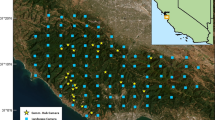Abstract
The behavioral response of the obligate bamboo-nesting ant Cataulacus muticus to nest flooding was studied in a perhumid tropical rainforest in Malaysia and in the laboratory. The hollow internodes of giant bamboo, in which C. muticus exclusively nests, are prone to flooding by heavy rains. The ants showed a two-graded response to flooding. During heavy rain workers block the nest entrances with their heads to reduce water influx. However, rainwater may still intrude into the nest chamber. The ants respond by drinking the water, leaving the nest and excreting water droplets on the outer stem surface. This cooperative 'peeing' behavior is a new survival mechanism adaptive to the ants' nesting ecology. Laboratory experiments conducted with two other Cataulacus species, C. catuvolcus colonizing small dead twigs and C. horridus inhabiting rotten wood, did not reveal any form of water-bailing behavior.
Similar content being viewed by others
Author information
Authors and Affiliations
Additional information
Received: 3 August 2000 / Accepted in revised form: 6 November 2000
Rights and permissions
About this article
Cite this article
Maschwitz, U., Moog, J. Communal peeing: a new mode of flood control in ants. Naturwissenschaften 87, 563–565 (2000). https://doi.org/10.1007/s001140050780
Issue Date:
DOI: https://doi.org/10.1007/s001140050780




